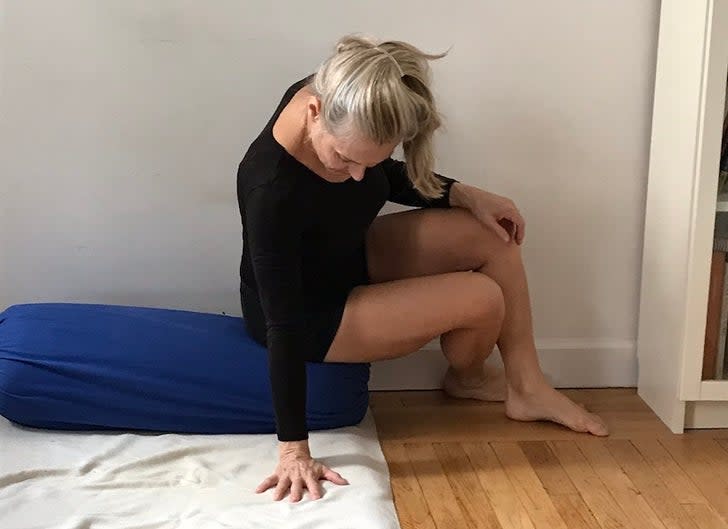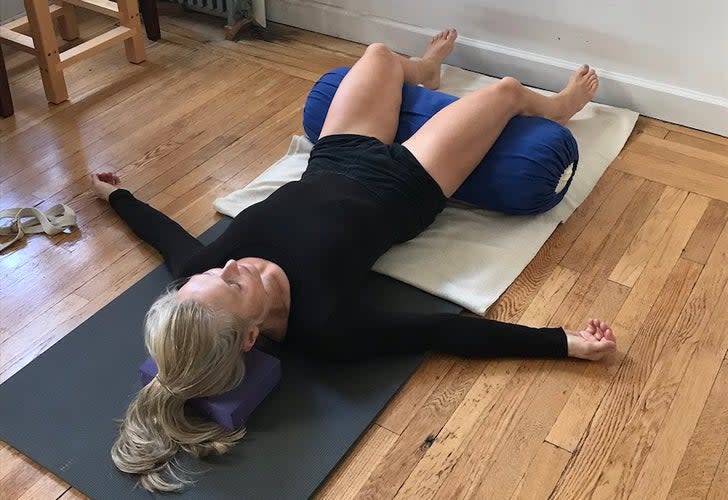Experts’ Recovery Tips For When The (Marathon) Party’s All Over
This article originally appeared on Womens Running
Follow The Doctor’s Orders After The Marathon
There's more to marathon recovery than the post-race poncho, celebratory medal and catching your breath. You've spent months getting your body ready to tackle those 26.2 miles. You are ready to calm your pre-race nerves and know how to cope during. But what about after the marathon?
Related: Women’s Running’s Complete Guide to Marathons
With the New York City Marathon one of the key fall marathons in the racing calendar, we have broken down the race and all the options for recovery after collection your medal in Central Park.
After you tackle the beautiful 26.2-mile NYC course, your body will need time, fuel and TLC to fully repair itself. To celebrate your accomplishments and minimize post-race soreness, follow these experts’ advice to ensure your best and fastest marathon recovery.
Dealing With Cooler Weather
The average temperature in November during the New York City Marathon ranges between the mid-40s and mid-60s (in degrees Fahrenheit). This year, temperatures leading up to race day have been nice for running, averaging in the 60s and 70s all week. But crossing the finish line covered in sweat can take your body from hot to cool immediately. Though you’ll be tired on Sunday, it’s important that you don’t let your body halt movement right after you finish running--especially if it ends up raining, as many expect it will.
Dr. Alexis Colvin, an orthopedic surgeon specializing in sports medicine at Icahn School of Medicine at Mount Sinai Hospital, expressed how important it is to continue moving once you cross the finish line. "Your body needs time to transition,” Colvin says. “Try to walk for at least 10 to 15 minutes, and be sure to grab a thermal blanket to keep yourself warm once you cool down." This will help your body adjust to the weather and keep your muscles from stiffening up.
Escape The Crowds
More than 50,000 participants are expected to cross the finish line in New York, and the crowds they create after doing so can cause a great deal of havoc for an athlete’s recovery.
Grab your post-race medal, the bits of food offered and a thermal blanket, and keep walking. This will help you escape the crowds and allow your body to cool down. Walk for 10 to 15 minutes before finding a place to stretch. Give yourself another 15 minutes or so to loosen your tight muscles by stretching, focusing on your quads, hamstrings, calves, IT bands and lower back.
Don’t Forget The Cooldown
It's necessary to allow yourself time to walk immediately after the marathon. Additionally, stretching and foam rolling are essential cool-down recovery methods that many coaches and physical therapists recommend. One post-race recovery tool many runners are tempted to steer clear from are ice baths and other types of cold therapy. Many athletes tend to use ice only if injured; however, on race day, you will have just worked your muscles to the max! After the hills and the long distance, those muscles will be stretched, tired and inflamed. Cold therapy can help reduce swelling and ease discomfort. Though the cold might feel uncomfortable, your body will thank you the next day.
Tip: Don't stop with the ice on marathon day-continue icing your legs for roughly 24 to 48 hours after the event.
Refuel With The Right Food
"Immediate post-NYC Marathon recovery--30 to 60 minutes--should include a replacement drink and other easily digested high-carbohydrate foods such as a banana, pretzels or a turkey sandwich," shares Dr. Colvin.
There should be plenty of water available once your cross the finish line, as well as sports drinks and other replacement fluids. You know best how your body will take to certain foods and drinks, because you have been incorporating post-recovery fuels into your training all along. Pick the fuel that works best for your body, or pack a light snack or drink into your gear bag before the race if you're food sensitive.
Refueling Options Near The NYC Marathon Finish Line
Head to one of these popular local restaurants, all located on the Upper West Side and easy to access from the Central Park finish line:
The Milling Room (446 Columbus Ave)
Gennaro (664 Amsterdam Ave)
For large groups: Carmine's (91st Street at Broadway)
Author’s tip: These restaurants have clean restrooms; if you can hold out, you won't have to wait in the extremely long portapotty lines!
Get Some Rest
After an epic race and celebratory day, your body will be tired. Once you've showered and are ready for bed, your body will continue to burn calories for hours, which will result in a warmer body temperature. To maximize your post-race recovery, make sure you have a sleep environment that enables air flow around your bed for temperature regulation.
Having a good mattress that supports proper spine alignment will also help. “Like your running stance, when you achieve the right posture at night-whatever your sleep position-you get the proper support for your skeletal structure that allows your blood to flow easily and your muscles to fully relax and repair from the stress of the race," says Shana Rocheleau, the vice president of strategy at Bedgear. "Finding your personalized fit of a complete sleep system-with your mattress and your pillow working together, along with your sheets and blankets-enables your body to recover and replenish your reserves to get back to your training plan."
If you're traveling to a marathon race, you can't control the bed you're sleeping in at a hotel. However, you can bring your own pillow, sleeping accessories or blanket that can help you achieve your best sleep alignment and help regulate your body heat.
Channel Your Inner Yogi
"Recovery after a marathon can take several weeks--even up to a month-so allow your body to relax, cross train and/or do lower impact activities such as yoga and Pilates," suggests Dr. Colvin.
Carrie Owerko, a yoga instructor and iyengar specialist, shares excellent relaxation and recovery yoga poses.
"One of the best is the Supta Padangusthasana (the hand to big toe pose)," says Owerko. "This pose helps lengthen the muscles in the legs, hips and lower back. It can also bring relief to tired feet, ankles and knees."
The Viparita Karani (inverted practice pose) is another relaxing stretch option. "It can help reduce inflammation in your feet and legs, as well as help soothe and calm your nervous system," shares Owerko.
Supta Padangusthasana (Reclining Hand To Big Toe)




Use a long yoga strap, or create a long belt by buckling two straps together so that they create a larger circle. Lie down and place one end of the belt loop around the top of your right leg near your hip joint. Place your left foot in the other end of the loop. Make sure the buckle is close to your right hip (that makes it easier to tighten the belt and receive additional traction to the muscles of your right hip and lower back). Draw your right leg into your chest and take several deep breaths. To tighten the belt, simply bend your left leg slightly, use your hands to tighten the loop, then stretch you left leg back out. Repeat the process with your other leg.
Viparita Karani (Inverted Lake Pose)






Place a bolster, a firm pillow or some rolled blankets near a wall. Lie on your right side with your outer right hip placed on the bolster and your right shoulder on the floor. Swing your legs up the wall so that your hips and lower back are supported on the bolster, while your head and shoulders are resting on the floor with your legs supported upwards on the wall. If it’s difficult to get the tops of your thighs close to the wall, just move the bolster out so that your legs can relax-even if they’re at an angle instead of lying straight. Place the wide belt loop around the outer edges of your feet and allow your legs to spread apart. Stay in this pose for up to five minutes. Then slide down, scoot away from the wall and relax your legs over the bolster. Place a blanket under your head and neck, cover yourself with and additional blanket and rest for as long as you like.
For exclusive access to all of our fitness, gear, adventure, and travel stories, plus discounts on trips, events, and gear, sign up for Outside+ today.

